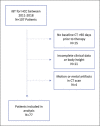Interstitial Brachytherapy for Hepatocellular Carcinoma: Analysis of Prognostic Factors for Overall Survival and Progression-Free Survival and Application of a Risk Stratification Model
- PMID: 37385234
- PMCID: PMC10716867
- DOI: 10.1159/000531732
Interstitial Brachytherapy for Hepatocellular Carcinoma: Analysis of Prognostic Factors for Overall Survival and Progression-Free Survival and Application of a Risk Stratification Model
Abstract
Introduction: Interstitial brachytherapy (iBT) is an effective treatment for hepatocellular carcinoma (HCC). Identification of prognostic factors is pivotal for patient selection and treatment efficacy. This study aimed to assess the impact of low skeletal muscle mass (LSMM) on overall survival (OS) and progression-free survival (PFS) of iBT in patients with HCC.
Methods: For this single-center study, we retrospectively identified 77 patients with HCC who underwent iBT between 2011 and 2018. Follow-up visits were recorded until 2020. The psoas muscle area, psoas muscle index, psoas muscle density (MD), and the skeletal muscle gauge were assessed on the L3 level on pre-treatment cross-sectional CT scans.
Results: Median OS was 37 months. 42 patients (54.5%) had LSMM. An AFP level of >400 ng/ml (hazard ratio [HR] 5.705, 95% confidence interval [CI]: 2.228-14.606, p = 0.001), BCLC stage (HR 3.230, 95% CI: 0.972-10.735, p = 0.026), and LSMM (HR 3.365, 95% CI: 1.490-7.596, p = 0.002) showed a relevant association with OS. Weighted hazard ratios were used to form a predictive risk stratification model with three groups: patients with low risk (median OS 62 months), intermediate risk (median OS 31 months), and high risk (median OS 9 months). The model showed a good prediction of 1-year mortality, with an AUC of 0.71. Higher MD was associated with better PFS (HR 0.920, 95% CI: 0.881-0.962, p < 0.001).
Conclusion: In patients undergoing iBT for HCC, LSMM is associated with worse OS. A risk stratification model based on LSMM, AFP >400 ng/mL, and BCLC stage successfully predicted patient mortality. The model may support and enhance patient selection.
Keywords: Hepatocellular carcinoma; Interstitial brachytherapy; Low skeletal muscle mass; Overall survival; Prognostic model; Progression-free survival.
© 2023 The Author(s). Published by S. Karger AG, Basel.
Conflict of interest statement
The authors have no conflicts of interest to declare.
Figures




References
-
- Sung H, Ferlay J, Siegel RL, Laversanne M, Soerjomataram I, Jemal A, et al. Global cancer statistics 2020 GLOBOCAN estimates of incidence and mortality worldwide for 36 cancers in 185 countries. CA Cancer J Clin. 2021 May;71(3):209–249. - PubMed
-
- ÖcalO, Rössler D, Ricke J, Seidensticker M. Advances in diagnostic and interventional radiology in hepatocellular carcinoma. Dig Dis. 2022 Jun;40(4):458–467. - PubMed
-
- Bauschke A, Altendorf-Hofmann A, Ardelt M, Kissler H, Tautenhahn HM, Settmacher U. Impact of successful local ablative bridging therapy prior to liver transplantation on long-term survival in patients with hepatocellular carcinoma in cirrhosis. J Cancer Res Clin Oncol. 2020 Jul;146(7):1819–1827. - PMC - PubMed
MeSH terms
Substances
LinkOut - more resources
Full Text Sources
Medical
Miscellaneous

